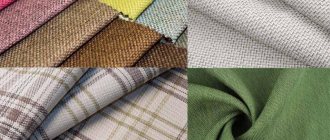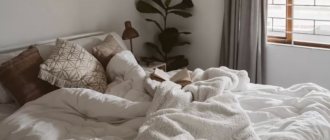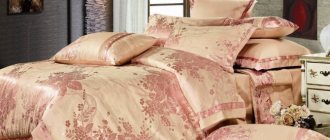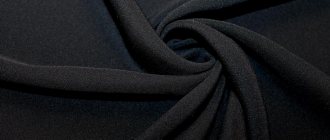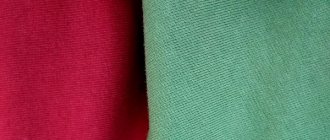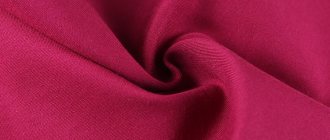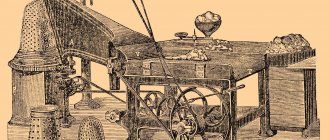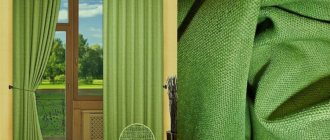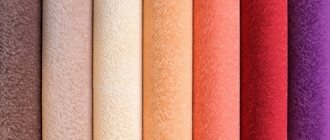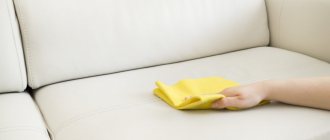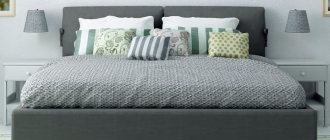Furniture fabric matting is a durable, wear-resistant material that is used for upholstery of upholstered furniture; we will tell you about the material with examples and photos.
When purchasing upholstered furniture, the buyer first of all pays attention to its design and upholstery material. It should not only be beautiful, but also durable, wear-resistant and easy to maintain. Exactly like the matting upholstery fabric shown in the photo. It has a special checkerboard pattern, so it will be quite difficult to confuse it with other materials.
There is a separate article on the website about this matter - you can find out about the composition and all its properties by reading here.
Matting is a furniture fabric that looks equally good in both rustic and modern styles.
It is made from natural materials such as linen, cotton, wool and silk.
Moreover, the percentage of content of a particular fiber determines whether the furniture fabric will have a smooth or fleecy surface and how bright its silky shine will be. Woven fabric is characterized by a variety of colors and textures. This plain-dyed fabric with a pattern applied to the surface is usually produced in a single color, as well as with a pattern (usually in the form of a strip), in a small or large “checkerboard.”
In addition to this article, you can read about this material in the article “Mesh curtains.”
Fabrics for furniture upholstery matting: characteristics
The following properties are characteristic of matting fabric for furniture upholstery:
- high strength and wear resistance - furniture material is resistant to abrasion and mechanical damage;
- softness - such upholstery is pleasant to the touch, makes the atmosphere in the house cozy and comfortable;
- breathability;
- hypoallergenic;
- environmental friendliness - the use of natural materials in the production of fabric;
- aesthetics - furniture material looks equally good either alone or in combination with leather, flock, etc.
- ease of care - the upholstery is wrinkle-resistant, practically does not get dirty and retains its original appearance for a long time.
Composition, characteristics
You will be pleasantly surprised by the variety of breathable materials from which the matting can be made. So, silk, linen, cotton or wool are actively used for its production. To achieve maximum strength of the material, its composition is supplemented with acrylic and polyester.
The percentage of natural raw materials: cotton or linen determines the weight, shine, and thickness of the matting. It is thanks to cotton or linen that the impeccable, silky smoothness of the fleecy material is achieved.
But what is the composition of polyviscose fabric and where such a product is used most often is indicated in this article.
If you want every touch of your favorite fabric to give you pleasure, choose the matting with the highest percentage of linen, cotton or silk.
The fabric is also successfully used for sewing curtains. It looks very original and textured in this design. A room where magic matting curtains hang will delight the surrounding decoration. You can show originality by upholstering decorative pillows with matting.
The matting is distinguished by the following characteristics:
- For its production, 100% fibers of wool, silk, etc. are used. In order to increase wear resistance and reliability, acrylic or polyester is added to the composition of the matting;
- It has a dense and rough texture, similar to burlap;
- It doesn't wrinkle;
- Possibility of operation for a long period of time.
On the video there is matting fabric:
Matting fabric for furniture: advantages and disadvantages
Matting upholstery fabric has the following advantages:
- high density and elasticity allows the material to keep its shape well. The upholstery does not deform even several years after the furniture has been used;
- is presented in a wide range of colors, patterns and textures, which makes it easy to choose furniture to match the walls and furniture;
- equally perfect for home and office interior design;
- furniture upholstery has an antibacterial effect, it does not harbor dust mites, it is hypoallergenic and environmentally friendly.
Application and care
This is one of the easiest materials to care for. It does not need to be washed or ironed. If a stain appears, dry cleaning with a vacuum cleaner is sufficient. As a last resort, you can simply moisten a sponge with any detergent and wipe the fabric.
If earlier it was popular as a material for sewing clothes, now the demand for it has fallen. Currently, matting fabric is used mainly as upholstery for furniture, as well as for sewing curtains and making accessories .
Matting comes in a wide variety of colors, so a sofa and other furniture with similar upholstery can fit into any interior. In addition, you can use it to sew curtains, blankets and other home textiles in the same style.
Interesting
Eco-style in the interior cannot be imagined without furniture upholstered with matting. This furniture material also fits organically and flawlessly into country or Provence styles, and the white upholstery also looks great in the Scandinavian style.
Not all products are suitable for caring for matting furniture. Read more about how to care for such upholstery material in our special section “How to care.”
Warning!
We tried to find a video without advertising, but unfortunately it didn’t work, but you can get a good idea of what this furniture material looks like:
Story
Matting has been known since ancient times, however, its original name was matting. Previously, this was the name for coarse household fabric, from which they sewed bags, coolies, and laid them on the floor. It was originally made from the cattail plant, which gave the canvas its name. Later, bast began to be used to produce the material.
Bast was made in places where there were a lot of linden trees. This process was labor-intensive and took quite a long time. First, ropes twisted out of it, which were soaked in water for a certain period of time. Then they began to weave mats from them. This was done by hand, there were no machines, so two standard mats were produced per day.
In the 20th century, this fabric was glorified by the famous Coco Chanel. She was the first to model and sew dresses, skirts, and blouses from it, which were especially popular among women.
How to choose a matting
When purchasing fabric, you need to pay attention to several indicators. When it comes to clothing, the composition is important. When choosing upholstery fabric, you should ask about the weight, which affects the density.
The denser the fabric, the more durable it is and the longer it retains its shape. This parameter must be at least 330 g per square meter. This is more important than the Martindale test. Abrasion is also an important characteristic. But the thread takes a very long time to wear out and stretches quickly.
And, of course, you should give preference to products from well-known manufacturers. The savings in this case are not justified. Cheap fabrics quickly lose their presentable appearance. They use dyes containing formaldehyde, which are hazardous to health.
Flaws
Despite a lot of positive characteristics, textiles have some negative aspects:
- Flowability. When cutting, the edges crumble a lot. This must be taken into account when calculating the amount of material and work with it carefully.
- High tendency to get caught. It is difficult to tear the fabric, but snags and tangles form very easily. Pet owners should keep this in mind. The claws of cats and dogs can quickly render the canvas unusable and ruin its appearance.
In recent years, manufacturers have learned to combat the problem of snags. They began to produce matting with an adhesive lining. When purchasing, you should check with the seller about the presence of an additional layer.
Types of material
Experts distinguish several types of fabric. The qualification is usually based on the scope of application.
Furniture
It has a mixed composition. Synthetic components increase wear resistance and resistance to mechanical damage. The surface can be smooth or with a slight pile.
Most often there is a plain upholstery matting, but there are also geometric patterns, mostly striped. Used for upholstery of sofas, armchairs, and other upholstered furniture. The material is resistant to stress, holds the filler well, preventing it from deforming and bunching, and is resistant to temperature changes and moisture.
Interior
This variety is used to sew single items (tablecloths, decorative napkins, pillows). But most often the fabric is used for the production of curtains. There are different options for density - from medium to high. You can also purchase blackout curtains made of matting, which prevent the penetration of ultraviolet radiation into the room by 90%. Curtain fabric will be appropriate:
- In the living room. It is better to give preference to options with eyelets. Gray color is suitable for minimalist interiors. For classics, choose more saturated shades.
- In the nursery. Natural curtains in beige, pink, and cream colors will create coziness in the room of children and teenagers.
- In the kitchen. The fabric is stain resistant and does not require special care. Varieties with ribbons are suitable as fastenings, as they are easily removable, making preparation for washing easier. And you have to wash kitchen curtains (unlike curtains for other rooms) often.
The material drapes well. Therefore, soft folds are easily created that will keep their shape throughout the entire service life.
Clothes
In the manufacture of this group, thin threads are used. There can be no talk of any synthetics or artificial additives. Only natural fabric is used. It combines well with other materials that are lighter in texture. Finishing with leather and metal parts is often found, giving a decorative effect to products made from matting.
On the textile market you can find printed matting that imitates the structure of flax. Its difference is the background pattern applied to the reverse side of the canvas. The production uses safe dyes that maintain the richness of the shades for many years.
Fabric care
Fabric care is kept to a minimum . Thick matting does not absorb odors and is not susceptible to stains, so it can be washed less often than other fabrics.
It can be washed by hand and in a machine. Just set the mode for clothes made from natural fabrics and at minimum speed. Caring for furniture upholstery made from matting is also quite simple. It is enough to vacuum the fabric during regular cleaning. In case of severe contamination, you can use a soap solution. It is forbidden to clean the matting with bleach or other products with corrosive properties.
The material does not require constant ironing. If you still have wrinkles that need to be smoothed out, you can iron it from the inside out.
What type of fabric is this?
The matting has a high density. As a result of double or triple weaving, textured squares appear on the surface, which alternate in a checkerboard pattern. This type of weaving is used in the production of burlap.
Matting color options
This material is often classified as chenille fabrics due to the type of weaving in which fluffy fibers are wound onto the main thread.
Composition and features of thread weaving
Today, matting is a fabric based on soft linen or cotton threads. Additionally, wool, silk, and viscose fibers can be included. They go through the stages of careful preparation, sorting depending on fiber length, processing, dyeing and drying. As a result of production operations, the price of the final product, which pleases with its pleasant texture, increases.
Natural materials do not tolerate external influences well, in particular the effect of direct ultraviolet radiation, therefore, to increase wear resistance, extensibility, strength, and also to reduce the cost of the fabric, polyester, nylon, and acrylic fibers are woven into its composition. Fabric with a high content of natural threads is characterized by a special shine and silky smoothness. Synthetic material is durable, irreplaceable in the household, but unattractive tactilely.
The modern matting has only the type of weaving left from its predecessor. Double or triple paired weaving of warp and weft fibers provides a surface of smooth textured squares, reminiscent of a chessboard, characteristic of matting. The type of weave affects the strength and tear resistance of the fabric.
At what approximate price does it sell?
Inexpensive domestic upholstery materials made from matting are sold in Russia from 290 to 400 rubles per linear meter.
Foreign designer fabrics with improved properties, for example, protection against color fading, will cost around 1000-1900 rubles per linear meter.
Thus, we can conclude that matting textiles are inexpensive to produce. It is easy to care for as it requires little ironing, making it a favorite material for practical people.
In conclusion, watch a video review of matting fabric:
